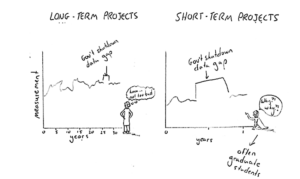
Sketching out the impacts of the government shutdown on NREL
By Jocelyn Lavallee and Nell Campbell
The shutdown of the US government that began October 1, 2013 has had repercussions felt across the nation and the world. Now that a resolution has been reached, we wanted to contribute a summary of impacts felt by NREL scientists during the last 16 days. With inspiration from Randall Munroe (creator of xkcd, and who contributed an infographic to the most recent issue of Science), we tried our hand at providing visuals to summarize this very serious subject, with just a touch of humor!
Why would NREL be a place where government shutdown effects reverberate?
The answers lie in two areas of impact that are likely little recognized outside of the realm of scientific research, including 1) federally-funded research, and 2) collaborations with federal research institutions, both of which are well represented by NREL and our researchers.
NREL has strong ties with many federal research agencies. In return for funding support and the exchange of data, NREL researchers produce analyses aimed to improve the understanding of important questions that impact our parks, wildlife, air and agricultural systems. Our researchers also help support better management of natural resources through the provision of recommendations and decision support tools. The government shutdown suspended most of these ties. Some of our researchers were furloughed or told to stop work on federal projects, and others lost access to databases, email accounts, and computer equipment needed for their research.
The closure of national parks was a huge conversation topic across the nation (see conversations about the effects on Estes Park, reopening parks using state funding, and the defense of the closures by the NPS). These closures affected NREL researchers who needed to collect end-of-the-season data.
However the shutdown also limited access to equipment, both for field research as well as laboratory analyses.
And, as a relatively minor (but for some, important) effect, people weren’t allowed to drive government vehicles, which prevented multiple researchers from accessing their field sites to collect data.
For some, these problems were a minor hiccup in the collection of very long datasets. For others conducting research on a narrower window of time, these problems were disastrous. For example, an end-of-season field sample may have provided the culminating information for project over one growing season (in Colorado, May – September), without which the other data are at best less conclusive or at worst meaningless. Or a laboratory project- which typically are done on a tight schedule after months or years of planning- may have happened to coincide with the shutdown. In this case, the experiment can be ruined, and either have to be repeated later or given up as a lost cause if sufficient funding is not available.


With the conclusion of the government shutdown, NREL scientists and collaborators look forward to not having to work around the variety of large and small inconveniences- cancelled meetings that stranded international attendees, for example.
Clearly the reverberations of the government shutdown have been deep and profound, both within and outside of the US. Many of the effects on science will be felt long into the future, especially by students. At NREL, we can only hope that this will be a minor bump in what has been, and hopefully will continue to be, a fruitful and enduring collaborative culture with federal agencies.
Featured image courtesy of quacktaculous via Flickr, under the Creative Commons license. Nell Campbell and Jocelyn Lavallee are both managers of EcoPress. They enjoyed drawing on their vast artistic skills for the purposes of this post.





